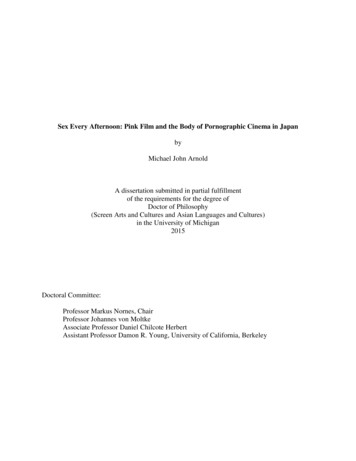
Transcription
Sex Every Afternoon: Pink Film and the Body of Pornographic Cinema in JapanbyMichael John ArnoldA dissertation submitted in partial fulfillmentof the requirements for the degree ofDoctor of Philosophy(Screen Arts and Cultures and Asian Languages and Cultures)in the University of Michigan2015Doctoral Committee:Professor Markus Nornes, ChairProfessor Johannes von MoltkeAssociate Professor Daniel Chilcote HerbertAssistant Professor Damon R. Young, University of California, Berkeley
Michael John Arnold 2015
For S.K.Don’t let it bring you down.It’s only castles burning.ii
AcknowledgmentsI cannot imagine a more fertile garden for my graduate studies than the University ofMichigan. The staff, faculty, and students at The Center for Japanese Studies, The Department ofAsian Languages and Cultures, and The Department of Screen Arts and Cultures made thedifficult parts of this journey effortless, and turned the seemingly routine parts of the journey intoan exciting challenge. Go Blue!The Department of East Asian Languages and Literatures at the University of Oregon hasbeen a warm environment for my final stages of writing. After each weekend of solitary,theoretical wrangling, the collegiality of my students and the professionalism of my comradeswould gently pull my feet back to the ground and remind me of the human dimensions ofJapanese and Area Studies. Go Ducks!Conducting fieldwork in Japan can at times be a confusing and frustrating endeavor. TheRackham Graduate School, The Ito Foundation for International Education Exchange, and TheJapan Foundation all gave sturdy support for my studies in Japan, both Pink-related andotherwise. I hope to share the knowledge and experience I gained on those voyages with theJapanese and Film Studies communities for years to come.iii
It was a thrill to study at Michigan with my Japanese media studies siblings, YukiNakayama and Irhe Sohn. I am excited to see what kids of discoveries they reveal to us in thefuture. It was also a pleasure to spend my class, office, and happy hours with Feroz Hassan,Nathan Koob, Josh Morrison, Dimitrios Pavlounis, and Katy Peplin. I treasure my memories ofscholarly debates about film and friendly conversations about Bob Dylan in West Park with myneighbor Benjamin Strassfeld. Michigan was my home for years, and I will always have fondmemories of the people I studied and worked with there.It has been my great pleasure to have Erin Hanna and Peter Alilunas as colleagues andconfidantes both at the University of Michigan and after. Erin and Peter are eloquent teachersand devoted scholars who have continually challenged my views on film, cultural studies, and‘adult’-hood. Yet, strangely, they still cannot beat me at Mario Kart or air hockey, and I alwayslap them at the sushi bar. I look forward to the next rematch.Tyler Cornelius and Jason Herlands helped me to understand both the pleasures and thetrials of graduate student life. I must have appeared incredibly naïve, all those years ago, askingmy college buddy Tyler how to write grad school applications as we ate midnight burgers at aDick’s drive-in in Seattle. When I participated in a literature seminar with Jason, my readings ofcanonical Japanese novels surely sounded like the ramblings of a child thumbing through acartoon flip book. The patience, friendship, and scholarship of these two men gave me the energyto continue studying through the seemingly endless, frozen winter nights of Ann Arbor. Jason,please give my love to Gen. Tyler, say “Hi!” to Lynne and Oscar for me. I look forward to thenext time I can meet you all, when we can again trade and translate the stories of our manyadventures.iv
Sharon Hayashi and Jasper Sharp were perhaps the first people to connect me to thebloodlines of the Pink industry in the formative stages of this project. Alex Zahlten and RolandDomenig paved the historical paths that made much of this work possible. To these and mymany other Pink Film studies senpai, you have my enduring gratitude.Saito Ayakō twice created an academic home for me at Meiji Gakuin University. Shefacilitated seminars, screenings, and post-curricular conversations that added depth andperspective to my studies in Japan. I consider myself lucky to have been one of her pupils, and Iam certain that her positive influence in Film Studies will be felt for decades to come.This research would have been impossible without the kindness and tolerance of critics,fans, actors, photographers, cinematographers, screenwriters, directors, assistant directors,cinema managers, producers, and other current and former film professionals who spoke with meat length about what it means to be Pink. Among them are Asakura Daisuke, Araki Tarō, DaiEjiri, Gotō Daisuke, Hamano Sachi, Hoshi Kyōko, Ikejima Yutaka, Ishikawa Kin, IsodaTsutomu, Itō Kiyomi, Kamata Kazutoshi, Katō Yoshikazu, Kimata Kimihiko, Kōda Riri,Komizu Kazuo, Konatsu, Meike Mitsuru, Mizuhara Kanae, Naka Mariko, Nakamitsu Seiji, ŌtaKōunki, Saitō Hidekazu, Sakaguchi Kazunao, Satō Hisayasu, Sekine Kazumi, SugimotoShinichi, Tajiri Yūji, Tsuda Ichirō, Ukai Kunihiko, Wakamatsu Kōji, and Zeze Takahisa. To allof you, and to those of you I have not mentioned or cannot mention, I apologize for being such anuisance. Thank you, from the bottom of my heart.I must give special thanks to Adachi Masao, Kaneda Satoshi, Satō Osamu, TanakaYasufumi, and Yoshiyuki Yumi—directors who permitted me to waste valuable moments oftheir films in my attempts to perform the role of an actor. Kawase Yōta initiated several of theseexchanges, and then made me swoon with his live and karaoke performances of Hall & Oatesv
songs. Rock on. I am also indebted to producer and director Fukuhara Akira, who was willing toshare his time, his attention, and his detailed knowledge of the inner workings of the Pink world.I hope to see you on the other side.Director Moriyama Shigeo transformed my research from academic theory into practicalfieldwork. Moriyama allowed me to observe the labor that takes place below the line, behind thescreen, and under the covers. Off-set, when we playfully engaged in late-night debates aboutmovies and pop culture, he schooled me in 1970s and 1980s Japanese rock music history. Today,whenever I look at my photos of the Pink set or listen to an Izumiya Shigeru album, I think ofMoriyama-san. Nemurenai yoru Yamamoto Naoki offered me companionship and incisive (at times extremely incisive)critique on both sides of the Pacific Ocean. I took his constant questioning of my research—“Butwhy would you want to study something like Pink Film?!”—as a challenge to complete thisproject. I am sure I have not yet answered that question to his satisfaction, but I hope he knowsthat his companionship was treasured and his criticism is and will always be duly noted (underthe right conditions).Hirasawa Gō enthusiastically facilitated more meetings between myself and filmprofessionals than I ever could have imagined. His devotion to the human elements of the moviesshould serve as a model for future scholars of radical Japanese cinema. I sincerely hope thatmore of his work will be made available to English-language audiences.My friends at Bamboo House and Rocket also contributed to this project in immeasurableways. I relieved the stress of research by trading rapid-fire anime and pachinko puns with Maito,an occasional Pink actor who had the guts to join me on multiple visits to adult cinemas in Tokyovi
and Yokohama. I also exchanged many jokes with Kyōko, whose seemingly casual questionsabout academia unbalanced my theoretical ramblings in revealing ways.Musician Katsu Hiroshi shared his deep knowledge of adult media in Japan and listenedas I vented my frustrations about life in the city. He relented when, in moments of depression, Ibegged him to play my Rod Stewart, Silberbart, and Black Bananas CDs on the bar stereosystem. We even invented a new cocktail together: The Gin Sonic.Oda Mayumi went out of her way to secure lodging for me when I otherwise would havebeen homeless during my last summer research trips—crucial moments that secured thetrajectory of my research. I would not have been able to make my final visits to doomed Tokyoand Osaka Pink Film theaters without Oda-san’s help.I have everlasting admiration and respect for my dissertation committee members DanielHerbert, Johannes von Moltke, and Damon Young. Johannes and Dan taught me how to read,how to write, and how to teach during and after my coursework at Michigan. Damon, whograciously accepted my invitation to join this project in its final stages, is now showing me newways to look at the things I thought I already knew. I cannot find sufficient words to thank youall. On ni kiru ze.None of this would have happened without my family. My parents John and Joyce andmy sister Keri are the three people who made me what I am today. They provided moral andmaterial support during my long periods of work and study in Japan, and they never oncequestioned my methods or my motives when I told them I was studying porn. Thank you.I am blessed to have had two talented main teachers guiding this project. My graduateresearch owes its existence and its completion to Markus Nornes. It was his enthusiasm as ascholar of Asian cinema that inspired me to apply to the University of Michigan, and hisvii
encouragement that enabled me to finish. Professionally, Markus’s seminars and lectures definedmy experience as a graduate student. Personally, his devotion to family, friends, and film pointeda spotlight on the many joys of life that are often overlooked when one dives head-first intoacademia. His books, especially Forest of Pressure, helped me to realize that it is possible foracademic writing to be as poetic as it is insightful. While I can only attempt to emulate thequality of Markus’s work, I hope that this project reflects the influence of his careful gaze andhis gentle, personal engagement with his studies and his students. Thank you, Markus.Finally, I thank Sano Kazuhiro. Sano is perhaps the only person in the world who couldhave convinced an anxious twenty-something cinephile like myself that movies are alwaysalready about people, and not things. His attention to the details of the physical world, his sharpobservations about film form and narrative, and—yes—his brutal, often painful criticisms ofothers’ work both crafted and then shaved away the artifice of the medium to which he devotedhis life. During the course of this project, Sano won a difficult war against cancer, but he lost hisability to speak—a curious condition for such a loud member of the film communities I describein this dissertation. Nonetheless, I am sure that we will continue to communicate in words andimages, and I will look forward to his next movie.Undoubtedly, Sano would love to yell at me for many of the odd observations I make inthe following pages, but that is all right. He knows what I am trying to say, and I hear his voiceloud and clear, resonating in my memories as he drunkenly screams out Neil Young lyrics at 6a.m., passionately condemns the obscenities and injustices of the world, and endlessly professeshis love for the people, however clean or dirty, around him. Sano-san, thank you, and fuck you!viii
Table of Upon Entering the Pink Movie Theater1Chapter 1History: Legends of the Pink Margin24Chapter 2On Location: Pink Photography and the Possibilities of Representation46Chapter 3The Pornography of Remediation: Adult Video and Pink Film79Chapter 4“I’m Not Here for the Movie.” Who are Pink Films For?126ConclusionUpon Leaving the Pink Movie Theater155Bibliography162ix
IntroductionUpon Entering the Pink Movie TheaterThe subject who speaks here must admit one thing: he loves entering a Pink movietheater. Finding myself again outside on the soiled and half-lit Shinjuku streets (somehow Ialways go to adult movies late in the afternoon, or at night), stiffly exiting some café, I walk insilence (I do not care much to talk before seeing a film); I am limp, a little nervous, jacket open,sweating: I am awake.1The entrances to Pink cinemas are like strange archaeological gateways, hidden amongthe glass and concrete of constantly remodeled stores and eateries and industrially overshadowedby the carpet and chrome of the pristine mini-theaters and large multi-screen, studio-brandedcomplexes that dominate commercial film viewing in Japan today. Neon-colored Pink cinemabanners struggle to project expiring claims to class and prestige in the face of a gentrifyingsociety, flaunting district titles and expired studio affiliations with a sense of authority thatrecalls the first run cinemas and second run art houses of the Golden Age of film. ShinjukuInternational Repertory Cinema; Cinema Roman Ikebukuro; Umeda Nikkatsu; Ueno OkuraTheater; Asakusa World Hall.21
The entrances to these crumbling buildings are announced with photocopied schedulesand hand-drawn banners that suggest a nostalgic counterpoint to the mass manufactured publicitymaterials adorning contemporary multiplexes. Signs scrawled in brightly colored paint quietlycall to the street with stereotypically eroticized film titles: The Widow in Mourning Dress: IWant It; Ripe Teacher: Soaking Wet Panties; The Housewife That Went Crazy for Young Men.3In the hallways and lobbies, posters—evicted years ago from their temporary homes on buildingwalls and telephone poles due to complaints from concerned citizens and changes in cityregulations—advertise past and current porn heroines and heroes from inside glass cases that arewashed only by the flicker of dying fluorescent lamps.As I take my first steps into that surreal illumination, I am very conscious of my ownvisibility. A pedestrian might notice, snickering at the cliché film titles as he continues on hisway to a more reputable matinee. The odd tourist, in a self-conscious performance of halffeigned surprise, may find an excuse to take photographs of the theater’s oddly antiquatedmarquee. A young couple exiting the pachinko parlor on the other side of the street, broke andexhausted from hours of unsuccessful gambling, could have a laugh at my expense: “He’s notreally going in there, is he?” However, most passersby will simply look the other way and slipinto the cityscape without revealing any expression of recognition or interest.The entrance to the Pink theater is hidden in plain sight, but it is increasingly hard toenvision. Its seductive power is rapidly diminishing in urban neighborhoods and city suburbswhere triple-feature public cinema screenings are little more than a figment of the imagination toall but those who remember how to imagine. The gaudy entrances to this odd world are strangelyinvisible, and customers entering those spaces are typically ignored by the eyes of the city. On2
long afternoons I would search the streets and strain my eyes to find these secret theaters, hopingfor a brief glimpse into the lingering effects of a dying film culture.This project is an exploration of the worlds of production, representation, and exhibitionin the rapidly collapsing industry of Japanese soft-core adult (“Pink”) cinema. It is an attempt totheorize, from the ground up, the spaces and meanings of contemporary adult cinema from the1980s to the mid-2010s, in a region where cheap 35mm sex film production and public pornscreenings have almost outlived the home video revolution. Blending production studies,historiographical research, and formal analysis, I have looked for ways to describe how PinkFilms and their audiences struggled to locate themselves as parts of an industry, a discourse, anda mode of spectatorship during what are perhaps the final decades of their existence.The bulk of my research took place on the floors and in the lobbies of different adulttheaters in Japan. As such, my journey began and ended with people. Introduced via colleaguesin academic and independent Japanese Film Studies, I eventually spent many late nights withstaff and cast members who had worked on films for Shintoho, Kokuei, Xces, and OkuraPictures, the central production and distribution studios active at the time. Fleeting professionalacquaintances grew into lasting personal relationships, and after countless hours talking withdirectors, screenwriters, actors, and producers, facilitated by conversations that were likelyinspired as much by my own misunderstanding of the Pink Film format as my acquaintances’difficulty in explaining it, I was eventually invited to observe the production of a number of PinkFilms, from the brainstorming and writing stage, to filming, and post-production audio dubbing.4I appeared on screen in six titles and in sound only in one other, and I translated Englishlanguage subtitles for two films.5 In addition to my off-set relationships with Pink Film creatorsand fans, this fieldwork became the basis of my effort to theorize the contemporary Pink Film3
through an active and physical engagement in the cinematic experience, an approach that is stillsorely underrepresented in scholarly studies of media, Japanese film, and pornography.My research was initially predicated on the belief that these cheap porno movies deservehistorical recognition and some of the critical attention they beg for. Beginning in the early1960s, Pink has existed as a commercial industry for more than 50 years. Like any otherestablished film industry, it has explored a wide variety of subjects, genres, and levels of quality.In recent years, dozens of Pink titles (out of thousands made—many of which are no longerextant) have entered into the ranks of global cult cinema via international film festivals andboutique DVD label releases. The movies of Pink auteurs like Wakamatsu Kōji, Adachi Masao,Zeze Takahisa, and Satō Hisayasu have attracted the attention of scholars and journalists withtheir historically resonant stories and incisive political commentary. Pink’s exaggeratedreputation as a training ground for mainstream Japanese film directors is one of the reasons itcontinues to gain a limited amount of critical attention today.Still, the bulk of Pink Film history is overlooked by the viewers and scholars alike. Inglobal terms, the audience for Pink Film is larger than it has ever been, but the Pink canonremains small and frozen in amber. Auteurist works are given priority while average titles arebrushed aside, despite the ability of even the most pedestrian and disposable of films to revealmoments of narrative or visual eloquence to attentive viewers. While a number of Pink Filmscholars and critics in recent years have engaged the industry directly from a variety ofmethodological approaches and produced valuable historiographical and theoretical analyses ofPink Film, access to materials and resources is difficult to obtain from overseas. Newer Englishlanguage writing on Pink Film struggles to engage the incredible diversity of production, whilemore historically detailed writing in Japan avoids the inherent contradictions of pornographic4
film exhibition. In the reality of this aging industry, in the lived world of the Pink cinemas wherethe films of Wakamatsu and auteur-oriented production studio Kokuei are at best an anomaly,where in a month of viewing you might see three Nitta Sakae films and not a single SatōHisayasu title, the films are little more than a sideshow.Despite the gaudy posters and glaring film titles, Pink cinemas that I regularly visitedconsistently reneged on their promises for a distracting and relieving erotic moving imagefantasy. As I entered these theaters, I would quickly realize (or remember—when one’s eyes areon the text, it is easy to forget the context) that the picture is corrupted and the sound is littlemore than a dull rumble. When I sat down, my attention drifted. The films’ settings werecontrived, the characters were barely developed, and the narratives were almost negligible.Secondary identification with character positions was moot. At their worst, Pink cinemasprovided a space to enjoy a tentative and temporary cinematic sleep where I could share thedreams of professional perverts. At their best, these spaces taught me to accept the fragileisolation of the public cinematic spectacle, an abstract elegy for the organic flicker of 35mmcelluloid film. I struggled to maintain my focus on the bland screen images before me. I oftenwondered: why am I here? Sometimes I did not look at the screen at all, and as my experiencegrew I began to wonder how the Pink world spread open an opportunity to imagine what notwatching film could mean for film and pornography studies.With increasingly limited means, and to dwindling audiences, these venues embody thechanging and elusive nature of cinematic exhibition. Viewers in these spaces gaze not at thescreen, but beyond to an imaginary world where—as a young Ikejima Yutaka was once warnedby his parents, decades before he emerged as the last international spokesperson for Pink cinemain the mid-2000s—movie theaters were considered mysterious, exciting, and potentially5
dangerous places.6 While Ikejima was one of the few Pink directors I did occasionally run into atthe adult cinema, his half-joking statement at the 2009 Pink Taishō awards ceremony reflectedcomments from many other Pink professionals I spoke to who actively discouraged me fromentering the specialty theaters that screened the films they made. Directors, actors, and producerswarned me of the dangers of watching a Pink Film in a Pink theater. My colleagues in Japanesefilm and media studies did the same. The idea of visiting an adult cinema, even for research, wasoften treated as if it was a joke, or worse, a threat to artistic prestige and to my own (and myassociates’) academic reputation.One of the most compelling warnings I received was from an established and wellpublished scholar and curator of radical Japanese cinema. When I invited him to join me to see amutual acquaintance’s feature film play at an adult cinema in Tokyo, he relayed a story abouthow he was sexually assaulted at a Pink cinema years ago. Still suffering the burden of thattrauma, he vowed to never return. Other friends and colleagues, both male and female, Japaneseand foreign, relayed stories of harassment and unwanted physical contact. When I raised thesestories with Pink production staff and cast members, they did not contest them; only rarely didthey comment on them at all. Responses to my initial requests for information from Pinkprofessionals commonly included a statement that I began to regard as a kind of stockcatchphrase: “If you need to watch my movies, I’ll give you a video copy. Just don’t go to thetheater.” For a time I heeded those warnings, and for the preliminary part of my research I visitedPink cinemas only a handful of times, and only while accompanied by friends. Occasionally Iwould be invited to pre-release screenings at the film lab, encouraged to enjoy the feature in asilent and professional environment, surrounded by the cast and crew of the feature I waswatching. I recall those films clearly, but I have dim memories of the venues I saw them in.76
When I returned to Japan to directly pursue research on Pink Film several years later, Idecided to ignore the warnings completely. For roughly the last year and a half of my research, Iattended screenings in thirty adult cinemas in Japan; roughly half of the theaters that were stillactive in the nation at the time. Over several trips between 2009 and 2013, I entered and exitedPink cinemas at least 130 times, and for the vast majority of those visits stayed for one full cycleof the multiple-feature program. It did not take long to realize that, with a few notable exceptions(such as the cramped Sekai Kessaku Gekijō, or World Masterpiece Theater, a 500 yen singlefeature cinema in Ueno where I was immediately surrounded, cornered, and groped both times Ientered it), my informants’ warnings were greatly exaggerated.Those warnings did leave one valuable impression on the development of this dissertationproject—the lesson that it is indeed not safe to watch films at a Pink cinema. I should clarify thatI do not mean to endorse the narrative that adult cinemas necessarily put spectators at physicalrisk; rather that they introduce viewers to a different kind of film world, one with different rulesand completely different social boundaries, where the status of the filmic object is uncertain. Inthe Pink cinema, one must always be careful, aware, patient, and on guard. I began to suspectthat my acquaintances’ warnings were intended to keep viewers focused on their work as itplayed on the screen (ideally a video screen), and isolate them from the carnivalesque,contrarian, and often chaotic environment of the cinemas that these films were raised to live in.I visited mainstream commercial and art cinemas in Japan scores of times during myresearch as well. Contemporary film spectatorship in Japan (as in any other region dominated bytransnational film industries) has rules. Customers purchase one ticket for one person for onefilm. You enter before the single-feature begins, and you exit when it is over. Ideally, you do notmove or speak. Barring the biological imperative to visit to the restroom, you do not stand up or7
leave your seat. You do not sleep. You sit in silence and watch. When it is over, you struggle tounderstand what you have seen, and perhaps a day or two later you share the story with friends toconvince them to also see (or avoid) the film. In this model, film becomes an informationdelivery device. The screen addresses “you”. This you pays attention, it reacts to what it hasseen, and it waits patiently in its seat until the credits end and the lights come up. These were therules of film viewing that I, a self-professed cinephile and film researcher, followed closely untilI eventually learned how to enter an adult cinema in Japan.Pink Film spectatorship has different rules. Those rules are usually posted on letter-sizedsheets of papers by the theater entrance, occasionally emphasized by cheap photo frames.Sometimes they are projected on the screen in slides or short public service announcementsbetween each cycle of the program. The rules typically state that customers must not engage inobscene behavior or steal other spectators’ belongings. Some state outright that cross-dressing isnot allowed. Don’t grope; go to the lobby if you want to smoke; be careful with matches. If youcommit an obscene act, the police will certainly be informed. Yet, perhaps by virtue of theirsuperficially ceremonial enunciation, these rules are easily, constantly, and almost ritualisticallybroken. In practice, the adult cinema in Japan operates according to unspoken laws that are muchmore complex than these instructions for social interaction, and are accordingly much harder toignore.The law of the Pink cinema insists that screen space is almost completely negligible, butsocial space is not. Everybody in the auditorium must be totally active, aware, and physically,tangibly present. Viewers are free to try to watch the movie, if they are so inclined, if they dare,and if they are lucky enough to be undisturbed. However they must always be ready to respondto the call of the physical world around them. Time is negotiable: films are shown in double,8
triple, or quadruple features with no designated entrance or exit time. Customers may enterwhenever they choose, and leave whenever they like. The start of the show is at 10 or 11 a.m.,when the metal shutters are raised and the theater opens for the day. The end of the show iseleven or twelve hours later (or for all-night programs, 5 a.m. the next morning), when the sameshutters are locked. Some attendees stay for hours at a time, but on any given day probably nosingle patron will remain for the full day’s program.The laws of spectatorship in this world reverse the conventional practices of public filmviewing—one film, one seat, one person, one identification. In the Pink cinema, identity isforfeited at the box office. The ticket price is a kind of bribe, or a declaration of independence: “Iam not who I am outside.” The stairway up to the second floor or down into the basement is aportal into an alternate space. Subjectivity is released, not to be replaced by screen illusions,actors’ performances, or other cinematic distractions, but to be deconstructed, reformed,multiplied, and then performed live in the seats, by the so-called viewers, on the auditoriumfloor, in the lobby and smoking lounges, and in the restrooms. The film is a prop, the auditoriumis the mise en scène, and everyone present is an extra.Usually located in a dark alley or hidden between imposing multi-story buildings, thePink cinema is cut off from the flow of traffic and culture on the streets. It is an unprotected andendangered space, where imaginary viewing subjects can come to rest and reflect. In a very realsense, the adult movie theater in Japan exists in a space somewhere between a museum of filmhistory and a public sperm bank, preserving and displaying a moving image material on theverge of collapse to audiences that follow an alternative and nearly forgotten set of codes andrules about film spectatorship. It offers a viewing experience that exaggerates the contrastsbetween disinterested ambivalence and absolute attention, between social escape and immediate9
(and immediately forgettable) fraternal activity. It is the site of a unique kind of translation,projecting simulated images of the most intimate and the most imitated human experiencesthrough an obvious moving image artifice, and channeling the spectator through a material,audio-visual portal from one set of social norms and expectations into another. As long as thestuttering 35mm projector can maintain the right focus and luminescence, the flickering light andshadow of the screen camouflage
and Osaka Pink Film theaters without Oda-san's help. I have everlasting admiration and respect for my dissertation committee members Daniel Herbert, Johannes von Moltke, and Damon Young. Johannes and Dan taught me how to read, how to write, and how to teach during and after my coursework at Michigan. Damon, who










